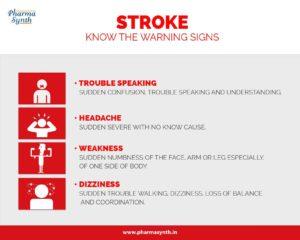 Know the warning signs
Know the warning signs
Stroke is a case of emergency. Acting fast during this critical time is vital to save the patient. Even if you cannot diagnose it as stroke, getting the patient to a nearby hospital or even calling 911 is worth trying; since the patient will be able to get some support which is very necessary. It will not only save the patient’s life but will also help prevent any long-term disabilities.
Through a research, the National Institute of Neurological Disorders and Stroke found that patients treated with anti-clotting drugs during the first 3 hours of having stroke symptoms have 30% more chances of recovering without any major disability.
FAST
The National Stroke Association came up using the term “FAST” to explain symptoms of stroke to people.
F – Face: a drooping or uneven smile on the patient’s face is a warning sign.
A – Arms: weakness or numbness in the arms and legs on either side of the body is another warning sign. If you are not sure about this, try to raise any one hand. If it drops immediately, it’s a sign.
S – Speech: slurred speech is another sign. Ask the patient to repeat something and you will understand if the language is unclear.
T – Time: you have to act as fast as possible if someone near you is having a stroke.
Other than these, the following symptoms may be seen:
– numbness in limbs, most likely on one side
– vision troubles in one or both eyes
– trouble in walking
– overall fatigue
Preparation and prevention
Such emergency cases can happen any time. Being prepared for this usually means having knowledge of the following things –
• “FAST” should be known by your friends and family.
• Have an updated medical history of the patient
• Have an emergency contact list on your phone.
• Have a copy of the current medication with you.
• Educate your children on how to call for help.
• If possible, try to get the address of a heart specialist in your area
How to prevent stroke?
After having the first stroke, there are chances of having another stroke sooner or later. So it is always best to prevent it. Following steps will guide you for prevention of stroke:
• Add vegetables, fruits, nuts and beans to your diet.
• Food full with fats should be avoided.
• Intake of sugar should be reduced. Along with sugar, salt, fats and refined grains should also be reduced. Cut down on cake and confessionary items. Even use of high calories beverages should be avoided.
• Exercise and increase your daily physical activity. A simple morning walk for 30 minutes will be good.
• Reduce the intake of alcohol.
• Tobacco intake should be reduced. Tobacco has a content, named nicotine that thickens the blood and thus increases the changes of stroke.
• Follow the current medication as advised. For paralysis or during major operations, patients are often kept on blood thinner. It is important to take them in order to keep the blood thin and help it flow towards all parts of the body.

